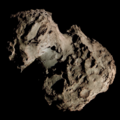 | |
| Discovery [3] | |
|---|---|
| Discovered by | Donald Machholz |
| Discovery site | Los Gatos, California |
| Discovery date | 13 September 1978 |
| Designations | |
| 1978 XIII, 1978l [4] | |
| Orbital characteristics [5] | |
| Epoch | 2 November 1978 (JD 2443814.5) |
| Observation arc | 322 days |
| Number of observations | 46 |
| Perihelion | 1.772 AU |
| Eccentricity | 1.00028 |
| Inclination | 130.64° |
| 290.68° | |
| Argument of periapsis | 224.75° |
| Mean anomaly | 0.0002° |
| Last perihelion | 13 August 1978 |
| Earth MOID | 0.942 AU |
| Jupiter MOID | 1.672 AU |
| Comet total magnitude (M1) | 8.3 |
Comet Machholz, formally designated as C/1978 R3, is a hyperbolic comet that was observed throughout late 1978. It is the first of 12 comets discovered by American astronomer, Donald Machholz. [6] He found the comet on 12 September 1978 while observing with a 25-cm reflector telescope from Los Gatos, California. He described it as a diffuse object without central condensation with an apparent magnitude of about 11. [6] The first parabolic orbit, calculated by M. P. Candy, indicated that at the moment of discovery the comet was past its perihelion and it was approaching Earth. [7]

